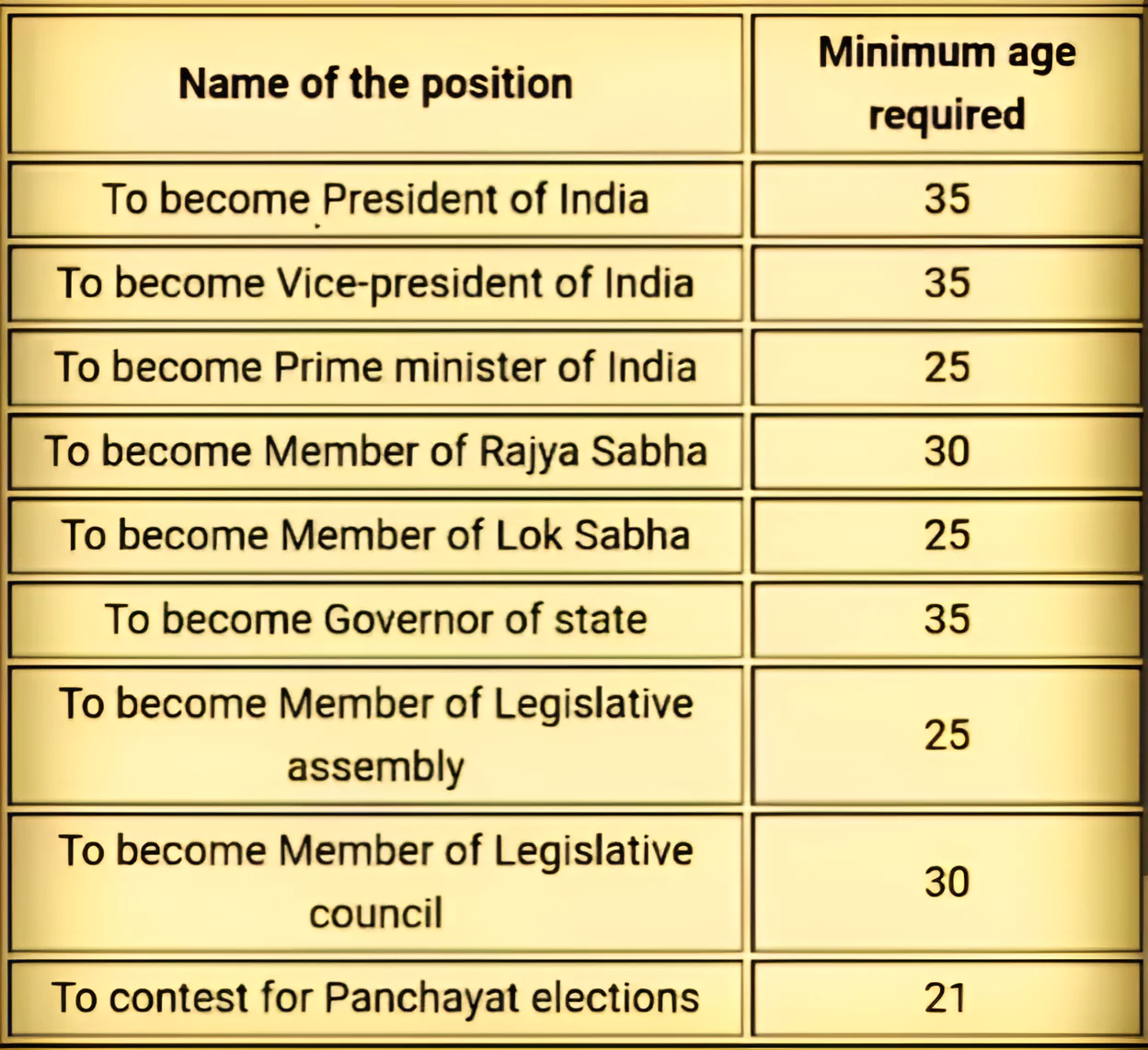The 132nd Report on Election Process and Reform, presented to the Rajya Sabha, recommends reducing the minimum age for candidacy with the voting age of 18.
| Relevance For Prelims: Indian Constitution,Indian Parliament, Parliamentary System Of Government, Election Commission Of India, Article 84 and Article 173 of Indian Constitution, Durgabai Deshmukh, and Private Members Bill.
Relevance For Mains: J.M Lyngdoh Committee Report,73rd Constitutional Amendment |
|---|
 Basis of this Age Reduction: Wisdom does not depend solely on age. Modern education is good enough to make the youth aware towards their civic rights and duties.
Basis of this Age Reduction: Wisdom does not depend solely on age. Modern education is good enough to make the youth aware towards their civic rights and duties.
Like other modern democracies worldwide, India should revisit age requirements. The age of candidacy has long been a topic of debate. The historical decisions laid a foundation, current global and national contexts
| Prelims PYQ (2017):
For election to the Lok Sabha, a nomination paper can be filed by (a) anyone residing in India. (b) a resident of the constituency from which the election is to be contested. (c) any citizen of India whose name appears in the electoral roll of a constituency. (d) any citizen of India Ans: (c) |
|---|
| Must Read | |
| NCERT Notes For UPSC | UPSC Daily Current Affairs |
| UPSC Blogs | UPSC Daily Editorials |
| Daily Current Affairs Quiz | Daily Main Answer Writing |
| UPSC Mains Previous Year Papers | UPSC Test Series 2024 |
Recently, the United Nations Climate Change Executive Secretary emphasized the urgency of the next two years in addressing climate change.
| Relevance For Prelims: Climate Change In India, Forest Rights Act 2006 And Rights Of Forest Dwellers, KUSUM Scheme, Pradhanmantri Suryodaya Yojana, India Records 76% Drop In Solar Module Imports, IREDA: Indian Renewable Energy Development Agency, and Sixth Session Of The International Solar Alliance (ISA).
Relevance For Mains: Commitment-action gap to meet the Paris Agreement targets, and steps have been taken to transition to renewable energy. |
|---|
We need to align our technological, economic, and institutional structures to maximise synergies between sustainability, climate change mitigation, and development related outcomes.
| Prelims PYQ (2015):
With reference to the Indian Renewable Energy Development Agency Limited (IREDA), which of the following statements is/are correct? 1. It is a Public Limited Government Company. 2. It is a Non-Banking Financial Company. Select the correct answer using the code given below. (a) 1 only (b) 2 only (c) Both 1 and 2 (d) Neither 1 nor 2 Ans: (c) |
|---|
| Mains Question: Why is it argued that India’s emphasis on renewable energy, especially biofuels, could compromise its food security. (10 marks, 150 words) |
|---|
| Must Read | |
| NCERT Notes For UPSC | UPSC Daily Current Affairs |
| UPSC Blogs | UPSC Daily Editorials |
| Daily Current Affairs Quiz | Daily Main Answer Writing |
| UPSC Mains Previous Year Papers | UPSC Test Series 2024 |
Recently, the Supreme Court has given its verdict that the use of abusive language on OTT platforms cannot be regarded as a criminal offense, as it would lead to an infraction of free speech and violate artistic creativity.
| Relevance For Prelims: Regulation Code For OTT Platforms In India, National Education Policy NEP 2020, Information Technology (Intermediary Guidelines and Digital Media Ethics Code) Rules 2021, Telecom Regulatory Authority Of India (TRAI).
Relevance For Mains: Over The-Top (OTT) Communication Services, its comparison with Telecom Service Providers (TSPs) and its associated challenges and needed measures. |
|---|
By promoting dialogue, advocating for ethical content creation, and instilling values of respect and dignity, we can strive towards a media landscape that enriches rather than diminishes our cultural heritage and societal fabric.
| Prelims PYQ (2017):
Which one of the following objectives is not embodied in the Preamble to the Constitution of India? (a) Liberty of thought (b) Economic liberty (c) Liberty of expression (d) Liberty of belie Ans: (b) |
|---|
| Must Read | |
| NCERT Notes For UPSC | UPSC Daily Current Affairs |
| UPSC Blogs | UPSC Daily Editorials |
| Daily Current Affairs Quiz | Daily Main Answer Writing |
| UPSC Mains Previous Year Papers | UPSC Test Series 2024 |
Shifting Dynamics in West Asia: US Foreign Policy,...
FICCI’s Report on Illicit Trade in India
Spam Calls, Policy Initiatives, Regulatory Challen...
Suicides and Entrance Examinations, Prioritizing M...
India Must Avoid Confrontation with Five Eyes Inte...
Chief Justice’s Call for Transformation unde...
<div class="new-fform">
</div>
